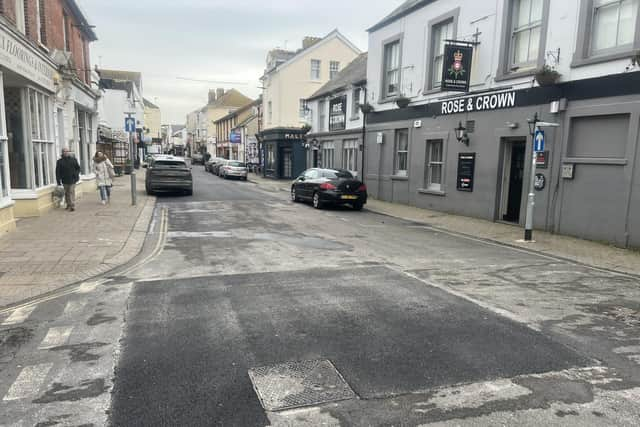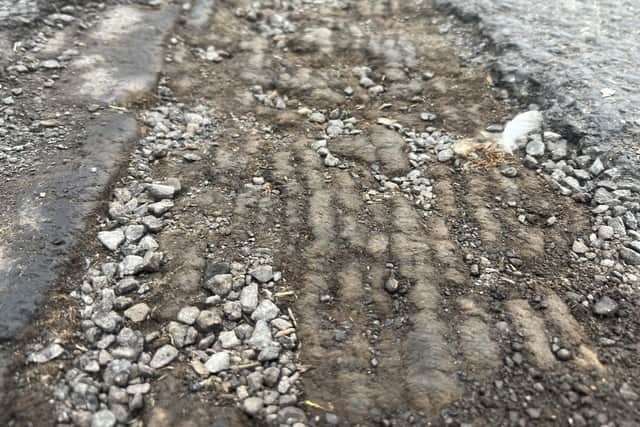Read about Worthing's humble beginnings after piece of history uncovered during road resurfacing works
and live on Freeview channel 276
Under the ground, wooden blocks were revealed, likely to date back more than 150 years. These type of wooden blocks were historically used to reduce the sound of horses’ hooves in the days before cars.
Turnpike roads in Sussex, like the old road from London to Worthing, however, were generally made using whinstone, the Kentish rag, broken into moderate-sized pieces.
Advertisement
Hide AdAdvertisement
Hide AdRight up until the early 19th century, Worthing had few roads. Interestingly, Thomas Badeslade's road map of 1742 shows no roads at all to the coast from London, though it does mark Worthing Shops and Lancing Shops.


The area west of Crescent Road and West Buildings was once farmland. Running west of South Street, along the line of Montague Street, was a track that ran over the West Field, towards Heene.
Prior to the building of Warwick House in the 1780s, Worthing was a fishing hamlet, smaller than neighbouring Broadwater, populated mainly by people working in agriculture and the fishing industry.
Advertisement
Hide AdAdvertisement
Hide AdThere was only one road, leading south from Broadwater to the coast, and a sparse scattering of properties.


Worthing began to grow after Londoner John Luther built a marine villa in High Street as a lodging house for wealthy visitors and the Earl of Warwick bought it. The arrival of Princess Amelia in 1798 saw the hamlet swiftly become a fashionable watering place on the south coast.
The hamlet soon increased in size, with building taking place in Montague Place, Bedford Row, The Steyne, Warwick Street and the east side of South Street.
After a decade of intense activity, during which Worthing acquired a theatre, assembly rooms, covered baths, a library and chapel, the Worthing Town Improvement Act was passed in 1803, giving it town status.
Advertisement
Hide AdAdvertisement
Hide AdProsperity faltered in the 1820s, in common with much of the country, due to economic depression, and the Board of Commissioners who governed the town was on the brink of bankruptcy.
It was crisis point. Worthing had to transition from the type of late 18th century watering place that was frequented by a relatively small number of upper class visitors to a holiday resort for all and residential seaside town.
The earliest record for buses in Worthing is 1841. The railway arrived in 1845 and gradually Worthing emerged radically different to its humble beginnings, a place where genteel families could enjoy quiet holidays.
Advertisement
Hide AdAdvertisement
Hide AdResidential development began in earnest in 1870, including the Gratwicke Estate to the west of the town centre and around Heene, a village with its own separate identity.
By 1890, Worthing had one of the county's largest communities and on August 25 that year, it was amalgamated with West Worthing and granted borough status.
Visitors could hire a horse and carriage from the seafront, by the hour or the day, with or without drivers.
The first 'horseless carriage' came to town on September 1, 1896, three months before Parliament passed the Light Locomotives Act.
Advertisement
Hide AdAdvertisement
Hide AdCars shared the roads with horses and there were numerous accidents when the animals took fright due to the vehicles' noise and vibration.
One such incident in August 1908 saw a tradesman's horse try to jump over a car but end up stuck across its bonnet. The horse had to be hauled off with ropes but it was the vehicle that came off worse.
Worthing's first motor agent, and sole provider of petrol, was Wills' cycle shop in Chapel Road. It was not long before the quiet, leisurely life of the town changed.
George Ilbury Warne, owner of Worthing's premier seafront hotel, arrived in 1899. He claimed Warne's had the first hotel garage in England and even implied it was the first home of the Royal Automobile Club.
Advertisement
Hide AdAdvertisement
Hide AdHe did much to popularise motoring in Worthing and even persuaded organisers of the British Automobile Club's week-long, 650-mile Car Reliability Trial to include the coastal town in its itinerary for 1902.
Most of the cars taking part had petrol-driven engines but several steamers were also on the run.It was the speed that concerned the authorities and around this time, anyone in Worthing caught 'driving furiously' – around 18mph to 20mph – faced a fine between £5 and £10.
There was even a bid to impose a 10mph speed limit on certain roads but the council was persuaded otherwise when Mr Warne offered to put up warning notices at his own expense.
Horse traffic moved at around 10mph to 12mph so it took time for residents to get used to the speed of cars. How times have changed!